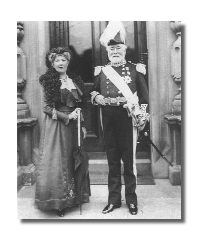
Lord Pirrie
On 29 July, the contract letter, described as 'a sheet of quarto paper making a formal agreement to do it, and that is all' was the understanding between the Oceanic Navigation Company and Harland and Wolff, for the construction of Olympic and Titanic, with a third sister to follow. The liners were to be built on the usual 'cost-plus' basis, with the owners specifying the particulars and amenities they desired and the builders supplying these without regard to specific contractual costs.

Lord Pirrie |
Lord Pirrie directly controlled the vessel's practical design, while the details - decorations, equipment and general arrangement for construction - initially were under the general manager Alexander M Carlisle's supervision. As the plans were developed, they were submitted to White Star director's for consideration. Perhaps a shipyard manager would accompany the plans to White Star's Liverpool officer: perhaps he might be asked to come over for subsequent discussion. Occasionally the White Star directors would confer directly with Pirrie at his London home . Ultimate decisions were J Bruce Ismay's responsibility. |
As sister ships, the Olympic and Titanic were virtually identical in their basic construction. They had four huge funnels and were triple-screw steamers, powered by two sets of four-cylinder reciprocating engines, each driving a wing propeller and with a 420-ton low pressure turbine driving the centre propeller by recycling steam from the main engines. The two outer propellers each had three blades, the centre propeller had four. The main engines produced 15,000 horse power apiece, with the turbine engine adding another 16,000 hp. This extra power was enough to give a top speed of 24 to 25 knots. The seam came from the boiler-rooms and each watertight boiler compartment had its own pumping equipment. The double-ended boilers measured 20ft long, 15ft 9in in diameter and containing just three furnaces. There were 159 furnaces in total, fueled a series of coal-bunkers with a combined capacity of more than 8,000 tons. Almost the entire space beneath upper deck E was occupied by the steam-generating plant, the coal bunkers were arranged so that handling the fuel for each boiler was reduced to a minimum. Of the four funnels, the foremost three catered for the boiler-rooms, while the fourth was used for ventilation.
Communication below decks was achieved via a system of illuminated telegraph linking the starting platform and the various bolier-rooms. This enabled the engineer on watch to issue his orders with speed and efficiency.
Work on the Olympic had progressed fewer than fifteen weeks when Titanic's keel was laid on 31 March 1909. The speed with which both ships were built represented no sacrifice to the highest quality standards. In design and construction the hulls exceeded any regulations then in effect. Compartmentalization conformed to the British Board of Trade's current requirements. Rivets were driven by hydraulic equipment, ensuring greater plating quality than conventional methods. The quality of work was described by one company designer as 'only a question of setting a standard and working to that standard by taking pains and spending money'. And spend Money they did. Titanic fully equipped cost about 1 500 000 pounds.
The Making of History
| Owners | A
Grand Design | Construction | Sister
Ships - Olympic and Britannic
|
| Strict Segregation | Outdated
Lifeboat regulations | The Aura of Invincibility
|
| Launch | Specifications
|
Leaving for the New World
| Southampton | Southampton
- The New York and a Near Miss | Cherbourg
| Queenstown |
Provisions |
Passenger Lists
| First Class | Second
Class | Third Class |
Alphabtical list | Crew
| The Band |
Lifeboat Lists
| Lifeboats 1- 3 | Lifeboats
4 - 6 | Lifeboats 7-9 | Lifeboats
10-12 | Lifeboats 13 -16 |
Collapsibles |
Aftermath
| American Inquiry |
| Causes - An extract from February 1995 Edition
of Popular Mechanic |
Facts and Figures
| Harland and Wolff's 101 Answers to
the most asked questions about the RMS Titanic |